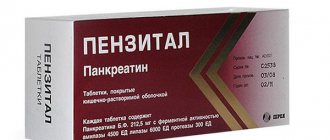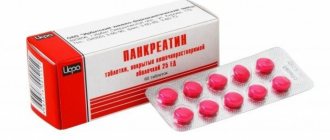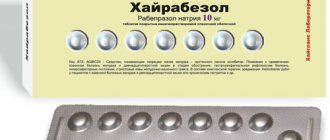Pharmacological properties
Pharmacodynamics.
The active ingredient of the drug Mezim Forte is a powder from the pancreas (pancreatin) of mammals, usually pigs, which, in addition to excretory pancreatic enzymes (lipase, alpha-amylase, trypsin and chymotrypsin), also contains other enzymes. Pancreatin also contains other related substances that do not have enzymatic activity. Pharmacokinetics. Suction. Powder from the pancreas is not absorbed in the gastrointestinal tract and is excreted in the feces. Most of it disintegrates or denatures under the action of digestive juices or bacteria.
Bioavailability. The enteric coating of the tablets, resistant to the action of gastric juice, protects acid-sensitive enzymes from inactivation when passing through the stomach. Only after reaching a neutral or slightly alkaline environment in the small intestine are enzymes released after dissolution of the membrane. Due to the fact that the powder from the pancreas is not absorbed into the gastrointestinal tract, there is no information on its pharmacokinetics and bioavailability.
The effectiveness of pancreas powder is determined by the degree and rate of enzyme release from the dosage form.
Application
Recommended dose per meal: 2–4 tablets Mezim Forte 10,000 or 1–2 tablets Mezim Forte 20,000 (corresponds to 20,000–40,000 units of e.f. lipase).
The dose of Mezim forte is determined according to the severity of the existing pancreatic insufficiency. Typically the recommended dose of lipase is 20,000–40,000 IU EF per meal, but it may be higher.
The goal of treatment with Mezim Forte is to achieve or maintain normal body weight and normalize the frequency of bowel movements or stool consistency. Increasing the dose should only be carried out under the supervision of a physician and in order to reduce the severity of symptoms (for example, steatorrhea, stomach pain).
The daily dose of enzymes should not exceed 15,000–20,000 units of lipase per kilogram of body weight.
Mezim Forte tablets should be swallowed whole, with plenty of liquid, during meals, since the effectiveness of the drug Mezim Forte may decrease when chewed; the enzymes contained in the drug, when released in the oral cavity, can damage its mucous membrane.
The duration of treatment depends on the course of the disease and is determined by the doctor.
Registration number: LP-001292 dated 11/28/2011
Trade name: Mezim® neo 10000
International nonproprietary or generic name: pancreatin
Dosage form: enteric capsules
Composition per capsule:
Capsule contents (enteric-coated mini-tablets):
Core: Active ingredient:
Pancreatin – 153.5 mg with minimal activity: lipase 10,000 units, amylase 9,000 units, protease 500 units
Excipients:
croscarmellose sodium – 5.12 mg, microcrystalline cellulose – 8.52 mg, hydrogenated castor oil – 1.709 mg, colloidal anhydrous silicon dioxide – 0.849 mg, magnesium stearate – 0.849 mg.
Shell : methacrylic acid and ethyl acrylate copolymer (1:1), 30% dispersion – 25.0 mg, triethyl citrate – 2.51 mg, simethicone emulsion 30% (dry weight) – 0.015 mg; talc – 5.01 mg;
Capsule: body:
gelatin – 36.20 mg, titanium dioxide (E 171) – 0.20 mg;
iron dye yellow oxide (E 172) – 0.20 mg; red iron oxide dye (E 172) - 0.01 mg; cap:
gelatin – 23,800 mg; titanium dioxide (E 171) – 0.400 mg; quinoline yellow dye (E 104) – 0.200 mg; indigo carmine (E 132) – 0.002 mg.
Description: opaque hard gelatin capsules of a cylindrical shape with hemispherical ends No. 2: the capsule body is light orange, the capsule cap is yellowish-green.
Capsule contents
: cylindrical mini-tablets, enteric-coated, light beige in color with a shiny surface.
Pharmacotherapeutic group: digestive enzyme agent
ATX code: A09AA02
Pharmacological properties
Pharmacodynamics
The active ingredient of Mezim® neo 10000 is pancreatin, which is a powder from the pancreas of pigs. The enzymes that make up pancreatin help break down fats, carbohydrates and proteins coming from food. Pancreatin, having proteolytic, amylolytic and lipolytic effects, compensates for enzymatic insufficiency of the pancreas, improves the functional state of the gastrointestinal tract (GIT), and normalizes digestive processes.
Pharmacokinetics
Gelatin capsules of the drug Mezim® neo 10000 quickly dissolve in the stomach, releasing mini-tablets coated with an enteric (acid-resistant) coating. Thus, the enzymes remain protected from inactivation in the acidic environment of the stomach. The release form of the drug ensures mixing of mini-tablets with intestinal contents and uniform distribution of enzymes. Dissolution of the mini-tablet shell and activation of enzymes occurs at a neutral or slightly alkaline pH in the small intestine. Pancreatin is not absorbed from the gastrointestinal tract and is excreted in the feces.
Indications for use
Replacement therapy for exocrine pancreatic insufficiency in adults and children in the following conditions:
- chronic pancreatitis;
- cystic fibrosis;
- pancreas cancer;
- conditions after surgical interventions on the pancreas and stomach (complete or partial resection of the organ);
- after irradiation of the gastrointestinal tract, accompanied by impaired digestion of food, flatulence, diarrhea (as part of combination therapy);
- narrowing of the pancreatic duct, for example due to a tumor or gallstones;
- Shwachman-Diamond syndrome;
- subacute pancreatitis;
- other diseases accompanied by exocrine pancreatic insufficiency.
Relative enzyme deficiency in the following conditions and situations:
- gastrointestinal disorders of a functional nature, with acute intestinal infections, irritable bowel syndrome;
- consumption of indigestible plant or fatty foods;
Preparation for x-ray and ultrasound examinations of the abdominal organs.
Contraindications
- acute pancreatitis;
- exacerbation of chronic pancreatitis;
- hypersensitivity to porcine pancreatin or other components of the drug.
Use during pregnancy and breastfeeding
Pregnancy
There are no clinical data on the treatment of pregnant women with drugs containing pancreatic enzymes. Animal studies have not revealed the absorption of pancreatic enzymes of porcine origin, therefore toxic effects on reproductive function and fetal development are not expected.
The use of Mezim® neo 10000 during pregnancy is possible if the expected benefit to the mother outweighs the possible risk to the fetus.
Breastfeeding period
Based on animal studies in which no negative effects of pancreatic enzymes were detected, no harmful effects of the drug on the child through breast milk are expected. You can take pancreatic enzymes while breastfeeding.
Directions for use and doses
The dose of Mezim® neo 10000 is selected individually depending on the severity of the disease, as well as the volume and composition of food taken.
Unless otherwise indicated, adults are recommended to take 2-4 capsules of Mezim® neo 10000 with each meal, swallowing the capsules whole (do not chew) with a sufficient amount of liquid (for example, a glass of water).
If it is difficult for the patient to take a whole capsule (for example, in small children or elderly patients), you can pour its contents, for example, into a glass, opening the capsule by separating the cap from the body, and then take the contents (mini-tablets) with a small amount liquids or added to liquid foods that do not require chewing (such as applesauce or fruit juice). The mixture of mini-tablets with food or liquid cannot be stored (take immediately after preparation).
Increasing the dose of the drug should be carried out only under the supervision of a physician, focusing on the dynamics of symptoms (for example, a decrease in steatorrhea, easing abdominal pain).
It is not recommended to exceed the daily dose of enzymes, which is 15,000-20,000 lipase units/kg of body weight.
The duration of treatment is determined by the doctor and depends on the course of the disease.
For children, the dosage regimen and duration of treatment are determined by the doctor depending on the severity of the disease and the composition of the food at the rate of 500 - 1000 lipase units / kg of the child’s body weight for each meal.
Use for cystic fibrosis
The dose of Mezim® neo 10000 depends on body weight and at the beginning of treatment should be 1000 lipase units/kg at each meal for children under 4 years of age, and 500 lipase units/kg at each meal for children over 4 years of age.
The dose of the drug should be selected individually depending on the severity of the disease, under the control of steatorrhea and the support of an optimal diet. For most patients, the dose should be no more than 10,000 lipase units/kg body weight per day or 4,000 lipase units/g fat consumed.
Side effect
Possible side effects are listed below in descending frequency of occurrence: common (> 1/100, < 1/10), uncommon (> 1/1000, < 1/100), rare (> 1/10000, < 1/1000), very rare (<1/10000), including isolated reports.
Gastrointestinal disorders:
Common:
nausea, vomiting and bloating.
Gastrointestinal disorders are mainly associated with the underlying disease. The incidence of the following adverse reactions was lower or similar to that observed with placebo: Very common:
abdominal pain;
Common:
diarrhea.
Skin and subcutaneous tissue disorders:
Rare:
rash;
Itching, urticaria - there is not enough data to estimate the frequency of cases
.
Overdose
Symptoms:
The use of large doses of pancreatic enzymes may be accompanied by hyperuricosuria and hyperuricemia in patients with cystic fibrosis.
Treatment:
drug withdrawal, symptomatic therapy.
Interaction with other drugs
No interaction studies have been conducted.
special instructions
In patients suffering from cystic fibrosis who received high doses of pancreatin preparations, strictures of the ileum, cecum and colon (fibrosing colonopathy) have been described. As a precautionary measure, if unusual symptoms appear or changes in the nature of the symptoms of the underlying disease, a medical examination is necessary to exclude damage to the colon, especially if the drug is used at a dose of more than 10,000 lipase units per kg of body weight per day.
Effect of the drug on the ability to drive vehicles and other mechanisms
Mezim® neo 10000 does not affect the performance of potentially hazardous activities that require special attention and speed of reaction.
Release form
Enteric capsules, 10000 units.
20, 50 or 100 capsules in a polypropylene bottle with a polyethylene cap equipped with a desiccant.
1 bottle along with instructions for use in a cardboard box.
Storage conditions
Store at a temperature not exceeding 25°C.
Keep the medicine out of the reach of children!
Best before date
2 years.
Do not use after the expiration date stated on the package.
Conditions for dispensing from pharmacies
Over the counter.
Manufacturer
Adair Pharmaceuticals S.r.l., Italy Via Martin Luther King, 13 20060, Pessano con Bornago Milan, Italy
Manufactured using Euroand Minitabs® Technology
Issue control
Berlin - Chemie AG Glinker Weg 125 12489, Berlin Germany
Organization receiving complaints from consumers:
LLC "Berlin-Chemie/A. Menarini", Russia 123112, Moscow, Presnenskaya embankment, building 10, BC "Tower on Naberezhnaya", Block B, tel., fax.
Side effects
To assess the frequency of side effects, the following classification is used: very often (≥1/10), often (≥1/100 and 1/10), infrequently (≥1/1000 and 1/100), rarely (≥1/10,000 and 1/1000), very rare (1/10,000), frequency unknown (estimate cannot be made from available data).
From the immune system. Very rare: immediate allergic reactions (skin rash, sneezing, lacrimation, bronchospasm, dyspnea), hypersensitivity reactions localized in the gastrointestinal tract.
From the gastrointestinal tract. Very rare: diarrhea, abdominal discomfort, abdominal pain, nausea, vomiting. The formation of strictures in the ileocecal region and in the ascending colon has been described after the administration of a preparation containing pancreatic powder in high doses.
Reports of suspected adverse reactions. Reporting of suspected adverse reactions after drug registration plays an important role. This allows continued monitoring of the benefit-risk ratio of the drug. Healthcare professionals should report any suspected adverse reactions.
Mezim forte 3500 units No. 20 tablet p.o.
Instructions for medical use of the drug MezimÒ forte Trade name MezimÒ forte International nonproprietary name No Dosage form Film-coated tablets Composition One tablet contains the active substance - pancreatin** (with a minimum activity of lipase 3,500 IU EF, amylase 4,200 IU EF, s minimum total protease activity 250 IU EF) excipients: microcrystalline cellulose, sodium starch glycolate (type A), colloidal anhydrous silicon dioxide, magnesium stearate, shell composition: polyacrylate 30% dispersion in terms of dry matter, talc, hypromellose, azorubic varnish ( E 122), simethicone emulsion, titanium dioxide (E 171), macrogol 6000. ** - pancreatin (pancreatic powder) Description Pink film-coated tablets, cylindrical in shape, with a plane-parallel surface, with a chamfer. Pharmacotherapeutic group Drugs that promote digestion, including enzyme preparations. Digestive enzyme preparations. Pancreatin. ATC code A09AA02 Pharmacological properties Pharmacokinetics Pancreatin is not absorbed in the gastrointestinal tract, but is excreted in the stool, and most of it is broken down and denatured under the influence of digestive juices or bacteria. Pharmacodynamics An enzyme preparation of pork origin contains pancreatic enzymes - amylase, lipase, trypsin and chymotrypsin, which facilitate the digestion of carbohydrates, fats and proteins, which facilitates their more complete absorption in the small intestine. The drug compensates for the insufficiency of the exocrine function of the pancreas and helps improve digestion processes. Indications for use Mezim® forte is used to replace digestive enzymes in cases of disorders of the exocrine function of the pancreas (for example, in chronic pancreatitis or cystic fibrosis), accompanied by digestive disorders, as well as in decreased absorption of nutrients due to flatulence, gastrocardial syndrome, and, in particular, after combined resection of the stomach and small intestine, with accelerated passage of food masses through the intestines (as a result of increased excitability or infectious diseases of the gastrointestinal tract), with disorders of the hepatobiliary system, dyspepsia, and in cases of simultaneous consumption of indigestible vegetables, fatty and unusual foods . In addition, Mezim® forte is used in preparation for diagnostic imaging studies (ultrasound, x-ray examinations) in order to eliminate intestinal bloating due to flatulence that has developed against the background of the digestive disorders described above. Method of administration and dosage The dose is determined individually depending on the degree of digestive disturbance. The tablets are not chewed and washed down with water. 1-2 tablets before meals. If necessary, take an additional 2-4 tablets with meals. It is not recommended to exceed the daily dose of enzymes, which is 15,000–20,000 IU of lipase per kg of body weight. The duration of treatment with Mezim® forte depends on the course of the disease and is determined by the attending physician. Side effects Very rare (<1/10,000) - immediate allergic reactions - allergic reactions from the gastrointestinal tract (such as diarrhea, stomach disorders and nausea) after taking pancreatic powder - stricture formation has been observed in patients with cystic fibrosis in the ileocecal region and ascending colon after high doses of pancreatic powder. Frequency unknown - in patients with cystic fibrosis, especially after taking high doses of the drug, urinary excretion of uric acid may increase. Therefore, in such patients, the excretion of uric acid in the urine should be checked to prevent the formation of uric acid stones - azorubine (E 122) can cause allergic reactions. Contraindications - hypersensitivity to pork, azorubine varnish (E 122) and other components of the drug - acute pancreatitis - chronic pancreatitis in the acute phase. However, episodic administration is acceptable in the phase of subsiding exacerbation when expanding the diet, if there are signs of residual or persistent disorder of pancreatic function - childhood and adolescence up to 18 years of age. Drug interactions When taking Mezim® forte, the absorption of folic acid may decrease, so you should take additional this drug. The effect of the oral antidiabetic drugs acarbose and miglitol may be reduced when taken concomitantly with Mezim® forte. Special instructions Mezim® forte contains active enzymes, which, when released in the oral cavity (for example, when chewing), can lead to damage to its mucous membrane with the possible formation of ulcers. Therefore, Mezim® forte must be taken without chewing, swallowing the tablet whole. In cystic fibrosis, if the required dose of pancreatin is exceeded, strictures (fibrous colonopathy) may develop in the ileocecal region and in the ascending colon. Pregnancy and lactation There are no sufficient data on the use of Mezim® forte in pregnant women. There is insufficient data on the effects on pregnancy, embryonic/fetal development, childbirth or postnatal development from animal experiments. Therefore, the potential risk to humans is unknown. In this regard, Mezim forte should not be taken during pregnancy and lactation, except in cases where it is absolutely necessary. Features of the effect of the drug on the ability to drive a vehicle or potentially dangerous mechanisms No special precautions are required. Overdose Symptoms: possible increased side effects of the drug. Treatment: symptomatic. Release form and packaging 20 tablets are placed in a blister pack made of polyvinyl chloride film and printed varnished aluminum foil, or polyamide/aluminum/polyvinyl chloride film and printed varnished aluminum foil, or polyvinyl chloride/polyethylene/polyvinylidene chloride film and printed varnished aluminum foil. 1 or 4 contour packages together with instructions for medical use in the state and Russian languages are placed in a cardboard pack. Storage conditions Store at a temperature not exceeding 30°C. Keep out of the reach of children! Shelf life 3 years Do not use after expiration date Conditions for dispensing from pharmacies Without a prescription Manufacturer Berlin-Chemie AG (Menarini Group) Glinker Weg 125 12489 Berlin, Germany Registration certificate holder Berlin-Chemie AG (Menarini Group) Glinker Weg 125 12489 Berlin, Germany Packaging organization Menarini-Von Heyden GmbH, Germany Address of the organization receiving claims from consumers regarding the quality of products (products) on the territory of the Republic of Kazakhstan: Representative office of JSC Berlin-Chemie AG in the Republic of Kazakhstan Telephone number: +7 727 2446183, 2446184, 2446185 fax number: +7 727 2446180 email address
special instructions
If unusual abdominal discomfort or changes in symptoms occur, it is recommended as a precautionary measure to undergo an examination to exclude intestinal damage, especially if the patient is using a dose of 20,000 U f.u. lipase per 1 kg of body weight per day.
The drug contains active enzymes that can damage the oral mucosa, including the formation of ulcers, so the tablets should be swallowed whole without chewing.
Mezim Forte should not be used in patients with rare hereditary forms of galactose intolerance, lactase deficiency or glucose-galactose malabsorption syndrome.
During pregnancy and breastfeeding. There is no sufficient data on the use of the drug Mezim Forte in pregnant women. There is insufficient data from animal experiments regarding the effects on pregnancy, embryo/fetal development, childbirth or postnatal development, so the potential risk to humans is unknown. In this regard, the drug Mezim forte should not be taken during pregnancy and breastfeeding, unless its use is absolutely necessary.
Children. The drug Mezim forte is used in children over 3 years of age. The dose and duration of use are determined by the doctor.
The ability to influence reaction speed when driving vehicles or working with other mechanisms. The effect of Mezim Forte on the ability to drive vehicles or operate other machinery is absent or insignificant.
Mezim 20000 20 pcs. enteric-coated tablets
pharmachologic effect
Replenishes pancreatic enzyme deficiency.
Composition and release form Mezim 20000 20 pcs. enteric-coated tablets
Enteric-coated tablets - 1 tablet:
- pancreatin - 220–293.34 mg with minimal activity: lipase - 20,000 units; amylase - 12000 units; protease - 900 units;
- excipients: lactose monohydrate - 83.34 mg; MCC - 72.66 mg; colloidal silicon dioxide - 1.6 mg; crospovidone (type A) - 10.4 mg; magnesium stearate - 2 mg;
- enteric coating: hypromellose - 6.25 mg; methacrylic acid and ethyl acrylate copolymer (1:1), dispersion 30% (dry weight) - 15.89 mg; triethyl citrate - 5.07 mg, talc - 9.6 mg; titanium dioxide (E171) - 6.58 mg; simethicone emulsion 30% (dry weight) - 0.43 mg; macrogol 6000 - 0.25 mg; carmellose sodium - 0.55 mg; polysorbate 80 - 0.88 mg; vanilla flavoring - 0.34 mg, bergamot flavoring - 0.16 mg.
Enteric-coated tablets, 20,000 units. 10 tablets each, enteric-coated, in a blister made of aluminum foil/aluminum foil. 1, 2 or 5 blisters are placed in a cardboard box.
Description of the dosage form
Round, biconvex tablets, film-coated, enteric-coated, white to white with a grayish tint, color with a smooth surface, with a specific odor, brown inclusions are possible at the break.
Directions for use and doses
Orally, during meals, without chewing and with a sufficient amount of liquid (for example, a glass of water).
The dose of Mezim® 20000 is set individually depending on the composition and severity of the disease.
Unless otherwise indicated, adults should take 1–2 tablets. the drug Mezim® 20000. It is possible to increase the dose, which should only be carried out under the supervision of a doctor, focusing on the weakening of symptoms (for example, steatorrhea, abdominal pain).
It is not recommended to exceed the daily dose of enzymes, which is 15,000–20,000 IU of lipase/kg.
For children, the dosage regimen and duration of treatment are determined by the doctor depending on the severity of the disease and the composition of the food at the rate of 1000 IU of lipase/kg for each meal.
The duration of treatment can vary from several days (for indigestion, dietary errors) to several months and even years (if constant replacement therapy is necessary).
Pharmacodynamics
Pancreatin is a powder made from porcine pancreas. Pancreatic enzymes, which are part of pancreatin, have a proteolytic, amylolytic and lipolytic effect and promote the breakdown of proteins, fats, carbohydrates, improve the functional state of the gastrointestinal tract, and normalize digestive processes.
Pharmacokinetics
Mezim® 20000 tablets are coated with an acid-resistant coating, which does not dissolve under the action of hydrochloric acid of the stomach and thereby protects the enzymes contained in the drug from inactivation. Dissolution of the shell and release of enzymes occurs at pH values close to neutral or slightly alkaline.
Indications for use Mezim 20000 20 pcs. enteric-coated tablets
- insufficiency of exocrine pancreatic function (chronic pancreatitis, cystic fibrosis);
- chronic inflammatory-dystrophic diseases of the stomach, intestines, liver, gall bladder;
- conditions after resection or irradiation of these organs, accompanied by disturbances in the digestion of food, flatulence, diarrhea (as part of combination therapy);
- to improve food digestion in patients with normal gastrointestinal function in case of dietary errors;
- preparation for x-ray examination and ultrasound of the abdominal organs;
- gastrointestinal disorders of a functional nature (with intestinal infectious diseases, irritable bowel syndrome).
Contraindications
- hypersensitivity to the components of the drug;
- acute pancreatitis or chronic pancreatitis in the acute stage (however, the appointment is acceptable in the phase of a fading exacerbation when expanding the diet, if there are signs of digestive disorders);
- hereditary galactose intolerance, lactase deficiency or glucose-galactose malabsorption syndrome;
- children under 3 years of age (for this dosage form).
Application Mezim 20000 20 pcs. Enteric-coated tablets during pregnancy and breastfeeding
There are no data on the use of digestive enzyme preparations during pregnancy and breastfeeding.
During pregnancy and breastfeeding, you can take Mezim® 20000 as prescribed by your doctor.
special instructions
In case of acute pancreatitis or exacerbation of chronic pancreatitis (at the stage of attenuation of the exacerbation), during a restorative diet, it is advisable to prescribe the drug Mezim® 20000 against the background of existing or remaining insufficiency of pancreatic function.
The effect of the drug on the ability to drive vehicles and operate machinery. Mezim® 20000 does not affect the speed of psychomotor reactions and the ability to perceive or assess a situation.
Overdose
There are no data on cases of overdose and intoxication with the drug.
Side effects Mezim 20000 20 pcs. enteric-coated tablets
Allergic reactions are possible; with prolonged use in high doses, hyperuricosuria may develop. In cystic fibrosis, if the required dose of pancreatin is exceeded, strictures (fibrous colonopathy) may develop in the ileocecal region and in the ascending colon.
Drug interactions
When taking medications containing pancreatin, the absorption of folic acid may be reduced.
The effect of oral hypoglycemic agents (acarbose, miglitol) may be reduced when used simultaneously with Mezim®20000.
With the simultaneous use of Mezim®20000 with iron preparations, the absorption of the latter may be reduced. The simultaneous use of antacids containing calcium carbonate and/or magnesium hydroxide may lead to a decrease in the effectiveness of the drug.
Note!
Description of the drug Mezim forte 20000 tablets. No. 20 on this page is a simplified author’s version of the apteka911 website, created on the basis of the instructions for use.
Before purchasing or using the drug, you should consult your doctor and read the manufacturer's original instructions (attached to each package of the drug). Information about the drug is provided for informational purposes only and should not be used as a guide to self-medication. Only a doctor can decide to prescribe the drug, as well as determine the dose and methods of its use.





